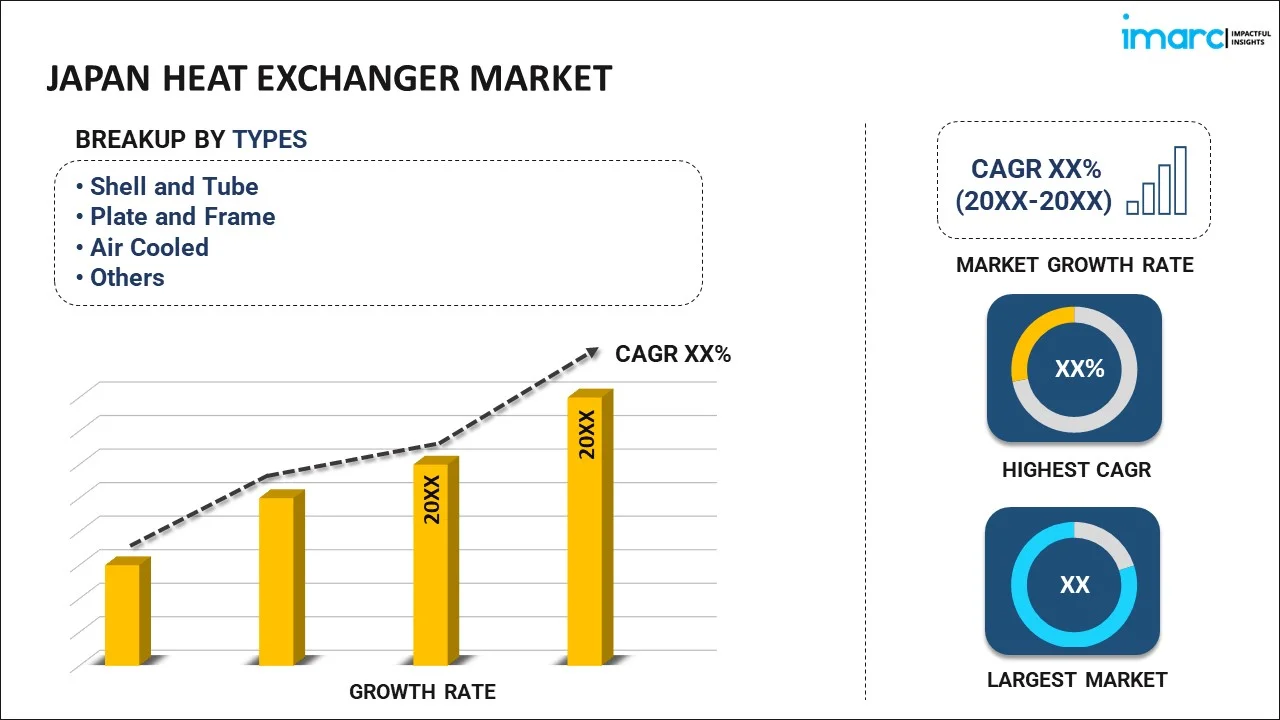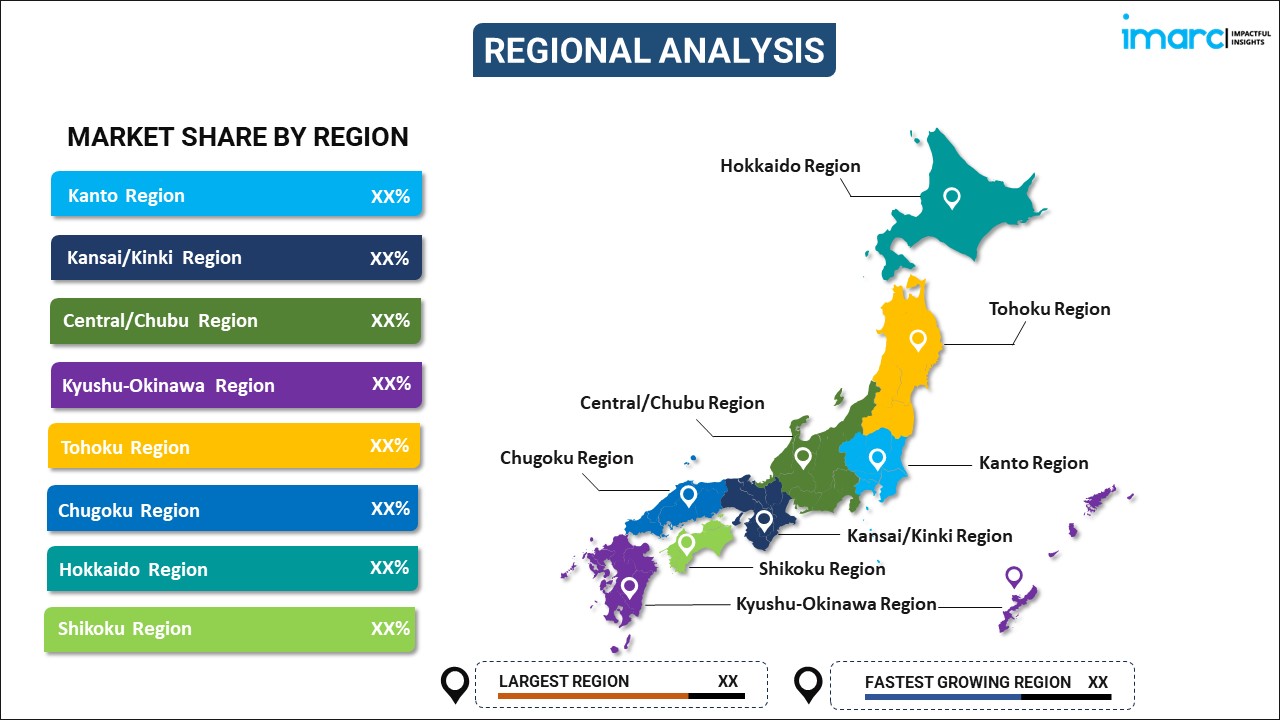
Japan Heat Exchanger Market Report by Type (Shell and Tube, Plate and Frame, Air Cooled, and Others), Material (Carbon Steel, Stainless Steel, Nickel, and Others), End Use Industry (Chemical, Petrochemical and Oil and Gas, HVAC and Refrigeration, Food and Beverage, Power Generation, Paper and Pulp, and Others), and Region 2025-2033
Market Overview:
Japan heat exchanger market size reached USD 1,129.3 Million in 2024. Looking forward, IMARC Group expects the market to reach USD 1,503.4 Million by 2033, exhibiting a growth rate (CAGR) of 3.1% during 2025-2033. The increasing emphasis on energy efficiency and sustainability in industries such as HVAC, power generation, and manufacturing, coupled with the rising demand for more efficient heat exchangers to reduce energy consumption and greenhouse gas emissions, is primarily driving the market.
|
Report Attribute
|
Key Statistics
|
|---|---|
|
Base Year
|
2024 |
|
Forecast Years
|
2025-2033 |
|
Historical Years
|
2019-2024
|
| Market Size in 2024 | USD 1,129.3 Million |
| Market Forecast in 2033 | USD 1,503.4 Million |
| Market Growth Rate (2025-2033) | 3.1% |
A heat exchanger is a mechanical device designed to transfer heat between two or more fluids, typically with different temperatures. Its primary purpose is to efficiently and safely exchange thermal energy from one fluid (often called the "hot" fluid) to another (referred to as the "cold" fluid) without them coming into direct contact. Heat exchangers play a crucial role in various industries and applications. They come in various shapes and sizes, but they all share a common principle: they have a surface area that facilitates the exchange of heat between the fluids. This surface area can take the form of tubes, plates, or coils. As the hot fluid passes over or through the surface, it releases its heat to the surrounding medium, which then heats up. Conversely, the cold fluid gains heat from the same surface, resulting in temperature adjustment for both fluids. Heat exchangers are utilized in heating, cooling, and heat recovery processes, including HVAC systems, refrigeration, power generation, and chemical processing.
Japan Heat Exchanger Market Trends:
The heat exchanger market in Japan is experiencing robust growth due to several key drivers. Firstly, the increasing demand for energy-efficient solutions has propelled the adoption of heat exchangers across various industries. Consequently, manufacturers are focusing on the development of advanced heat exchanger technologies to meet this growing demand. Furthermore, the emphasis on environmental sustainability and stringent regulations on emissions have driven the need for heat exchangers in industries like automotive, HVAC, and manufacturing. As a result, companies are investing heavily in R&D to create heat exchangers that reduce energy consumption and minimize greenhouse gas emissions. In addition to this, the rising utilization of renewable energy sources, such as solar and wind power, which require heat exchangers for efficient transfer of heat for various processes, is also augmenting the market growth. Moreover, the expanding industrial infrastructure, coupled with the increasing demand for heat exchangers in applications, such as power generation and chemical processing is expected to drive the heat exchanger market in Japan during the forecast period.
Japan Heat Exchanger Market Segmentation:
IMARC Group provides an analysis of the key trends in each segment of the market, along with forecasts at the country level for 2025-2033. Our report has categorized the market based on type, material, and end use industry.
Type Insights:

- Shell and Tube
- Plate and Frame
- Air Cooled
- Others
The report has provided a detailed breakup and analysis of the market based on the type. This includes shell and tube, plate and frame, air cooled, and others.
Material Insights:
- Carbon Steel
- Stainless Steel
- Nickel
- Others
A detailed breakup and analysis of the market based on the material have also been provided in the report. This includes carbon steel, stainless steel, nickel, and others.
End Use Industry Insights:
- Chemical
- Petrochemical and Oil and Gas
- HVAC and Refrigeration
- Food and Beverage
- Power Generation
- Paper and Pulp
- Others
The report has provided a detailed breakup and analysis of the market based on the end use industry. This includes chemical, petrochemical and oil and gas, HVAC and refrigeration, food and beverage, power generation, paper and pulp, and others.
Regional Insights:

- Kanto Region
- Kansai/Kinki Region
- Central/ Chubu Region
- Kyushu-Okinawa Region
- Tohoku Region
- Chugoku Region
- Hokkaido Region
- Shikoku Region
The report has also provided a comprehensive analysis of all the major regional markets, which include Kanto Region, Kansai/Kinki Region, Central/ Chubu Region, Kyushu-Okinawa Region, Tohoku Region, Chugoku Region, Hokkaido Region, and Shikoku Region.
Competitive Landscape:
The market research report has also provided a comprehensive analysis of the competitive landscape in the market. Competitive analysis such as market structure, key player positioning, top winning strategies, competitive dashboard, and company evaluation quadrant has been covered in the report. Also, detailed profiles of all major companies have been provided.
Japan Heat Exchanger Market Report Coverage:
| Report Features | Details |
|---|---|
| Base Year of the Analysis | 2024 |
| Historical Period | 2019-2024 |
| Forecast Period | 2025-2033 |
| Units | Million USD |
| Scope of the Report | Exploration of Historical Trends and Market Outlook, Industry Catalysts and Challenges, Segment-Wise Historical and Future Market Assessment:
|
| Types Covered | Shell and Tube, Plate and Frame, Air Cooled, Others |
| Materials Covered | Carbon Steel, Stainless Steel, Nickel, Others |
| End Use Industries Covered | Chemical, Petrochemical and Oil and Gas, HVAC and Refrigeration, Food and Beverage, Power Generation, Paper and Pulp, Others |
| Regions Covered | Kanto Region, Kansai/Kinki Region, Central/ Chubu Region, Kyushu-Okinawa Region, Tohoku Region, Chugoku Region, Hokkaido Region, Shikoku Region |
| Customization Scope | 10% Free Customization |
| Post-Sale Analyst Support | 10-12 Weeks |
| Delivery Format | PDF and Excel through Email (We can also provide the editable version of the report in PPT/Word format on special request) |
Key Questions Answered in This Report:
- How has the Japan heat exchanger market performed so far and how will it perform in the coming years?
- What has been the impact of COVID-19 on the Japan heat exchanger market?
- What is the breakup of the Japan heat exchanger market on the basis of type?
- What is the breakup of the Japan heat exchanger market on the basis of material?
- What is the breakup of the Japan heat exchanger market on the basis of end use industry?
- What are the various stages in the value chain of the Japan heat exchanger market?
- What are the key driving factors and challenges in the Japan heat exchanger?
- What is the structure of the Japan heat exchanger market and who are the key players?
- What is the degree of competition in the Japan heat exchanger market?
Key Benefits for Stakeholders:
- IMARC’s industry report offers a comprehensive quantitative analysis of various market segments, historical and current market trends, market forecasts, and dynamics of the Japan heat exchanger market from 2019-2033.
- The research report provides the latest information on the market drivers, challenges, and opportunities in the Japan heat exchanger market.
- Porter's five forces analysis assist stakeholders in assessing the impact of new entrants, competitive rivalry, supplier power, buyer power, and the threat of substitution. It helps stakeholders to analyze the level of competition within the Japan heat exchanger industry and its attractiveness.
- Competitive landscape allows stakeholders to understand their competitive environment and provides an insight into the current positions of key players in the market.
Need more help?
- Speak to our experienced analysts for insights on the current market scenarios.
- Include additional segments and countries to customize the report as per your requirement.
- Gain an unparalleled competitive advantage in your domain by understanding how to utilize the report and positively impacting your operations and revenue.
- For further assistance, please connect with our analysts.
 Inquire Before Buying
Inquire Before Buying
 Speak to an Analyst
Speak to an Analyst
 Request Brochure
Request Brochure
 Request Customization
Request Customization




.webp)




.webp)












